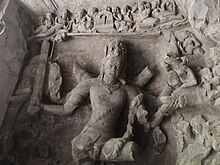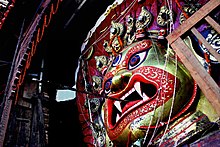Bhairava
| Bhairava | |
|---|---|
 12th-century Bhairava sculpture | |
| Affiliation | Shiva |
| Mantra | ॐ भैरवाय नमः ॥ oṁ bhairavāya namaḥ |
| Weapon | Trishula, Khaṭvāṅga, Sword, Kapala, Sickle, Vajra, Noose, Pinaka bow, Pashupatastra arrow, Pestle and Damaru |
| Day | Tuesday and Sunday |
| Number | 33 |
| Mount | Dog |
| Festivals | Bhairava Ashtami |
| Consort | Bhairavi |

| Part of a series on |
| Shaivism |
|---|
 |
| Scriptures and texts
|
| Philosophy
|
| Practices |
| Schools
Saiddhantika Non - Saiddhantika
|
| Scholars |
| Related
|
 Hinduism portal Hinduism portal |
|
Bhairava (Sanskrit: भैरव, lit. 'frightful'), or Kala Bhairava, is a Shaivite and Vajrayāna deity worshipped by Hindus and Buddhists. In Shaivism, he is a powerful manifestation, or avatar, of Shiva.[1][2][3] In the tradition of Kashmir Shaivism, Bhairava represents the Supreme Reality, synonymous to Para Brahman.[4][5] Generally in Hinduism, Bhairava is also called Dandapani ("[he who holds the] danda in [his] hand"), as he holds a rod or danda to punish sinners, and Svaśva, meaning, "he whose vehicle is a dog".[6] In Vajrayana Buddhism, he is considered a fierce emanation of boddhisatva Mañjuśrī, and also called Heruka, Vajrabhairava, and Yamantaka.[7][8]
Bhairava is worshipped throughout India, Nepal, Indonesia, Sri Lanka, and Japan, as well as in Tibetan Buddhism.[9][10]
Etymology
Bhairava originates from the word bhīru, which means "fearsome". Bhairava means "terribly fearsome form". It is also known as one who destroys fear or one who is beyond fear. One interpretation is that he protects his devotees from dreadful enemies, greed, lust, and anger. These enemies are dangerous as they never allow humans to seek God within. There is also another interpretation: Bha means creation, ra means sustenance and va means destruction. Therefore, Bhairava is the one who creates, sustains and dissolves the three stages of life. Therefore, he becomes the ultimate or the supreme.[11][full citation needed]
Hinduism

Legend


The legend of the origin of Bhairava is traced back to a conversation between Brahma and Vishnu described in the Shiva Purana.[12]
Shiva manifested as a pillar of light to settle the dispute of superiority between Brahma and Vishnu. Brahma dishonestly proclaimed his victory, stating that he had discovered the higher end of the pillar of light. To punish him for his dishonesty and arrogance, Shiva produced Bhairava from the region between his brows. When Bhairava sought instruction from Shiva, the deity directed him to, "worship Brahma with his sharp-pointed quick-moving sword". Bhairava decapitated the fifth head of Brahma for uttering the falsehood. Vishnu interceded on Brahma's behalf and sought mercy, and the two deities then worshipped Shiva.[13]
Having committed the sin of brahmahatya (the murder of a Brahmin) by decapitating Brahma, Bhairava was pursued by the terrible female personification of the sin. The skull of Brahma was still attached to his hand. To expiate himself of the sin, Bhairava roamed the three worlds. He visited Vaikuntha, where he was honoured by Vishnu and Lakshmi. When Bhairava visited Kashi, the city of the liberated, Brahmahatya left him, and the skull of Brahma was released from his hand.[14]
In another legend, Brahma is regarded to have stated to Vishnu to worship him as the supreme creator of the universe. Noting that both Shiva and he had five heads, Brahma came to believe that he was identical to Shiva and was equal to his powers. When his arrogance started to affect his role in the universe, Shiva threw a lock of his hair from his head. This assumed the form of Bhairava, who decapitated one of Brahma's heads. When the skull (kapala) of Brahma was held in the hand of Bhairava, the creator deity's ego was destroyed and he became enlightened. In the form of Bhairava, Shiva is said to guard each of the Shakti Pithas (A group of temples dedicated to the goddess Shakti). Each Shakti Pitha is accompanied by a temple dedicated to Bhairava.[15][16]
There is another school of thought that states that Shiva himself created Bhairava. It states that there was once an asura named Dahurāsura, who got a boon that he could be killed only by a woman. Parvati took the form of Kali to kill him. The wrath of Kali killed the asura. After killing the asura, her wrath metamorphosed as a child. Kali fed the child with her milk. Shiva made both Kali and the child to merge with him. From this merged form of Shiva, Bhairava appeared in his eight forms (Aṣṭāṅga Bhairavas). Since Bhairava was thus created by Shiva, he is sometimes said to be one of the sons of Shiva.[17]
The Puranas also give a version of Bhairava. In this version, there was a war between devas and asuras. To eradicate the asuras, Shiva created Kala Bhairava, from whom the Aṣṭāṅga Bhairavas were created. These Ashta Bhairavas married the Ashta Matrikas. Both groups of these deities are described to possess dreadful forms. From these Ashta Bhairavas and Ashta Matrikas, 64 Bhairavas and 64 Yoginis were created.[18]
Depiction


Normally in Shiva temples, idols of Bhairava are situated in the north, facing Southern direction. He is also called Kṣhetrapāla. He appears in a standing position with four hands. His weapons are drum, pāśa (noose), trident and skull. In some forms of Bhairava, there are more than four hands. He appears with a dog. His weapons, the dog, protruding teeth, terrifying looks, and a garland with red flowers all give him a furious appearance.[19][20]
In all Shiva temples, regular puja (reverence) rituals begin with Surya and end with Bhairava. Devotees offer what is understood to be favored by Bhairava: a ghee bath (abhiṣeka), red flowers, ghee lamp, unbroken coconut, honey, boiled food, fibrous fruits etc. If a Bhairava idol is facing west, it is good; facing south is moderate; facing east is not good. The right time to pray to Bhairavi is midnight. At midnight it is said that Bhairava and his consort Bhairavi will give darśana (appearance) to their devotees. The most appropriate time is a Friday midnight. There are eight types of flowers and leaves used in archana (अर्चन) to Bhairava.[21][22]
In Kashmir Shaivism, Bhairava is the ultimate form of manifestation or pure "I" consciousness.
One of his forms is called Svarṇākarṣṇa Bhairava ; In this form, he has red or blue complexion and is clothed in golden dress. He has the moon over his head. He has four hands, one of which he holds a golden vessel. He gives wealth and prosperity. Performing pūja on Tuesdays gives quick results. In some of the ancient texts he is said to have thirty two hands, the shape of a bird, golden complexion, terrible teeth, and a human form above the hip. Worshipping him destroys enemies.[1][23]
Some forms of Bhairava are guardians of the eight cardinal points. There are 64 Bhairavas. These 64 Bhairavas are grouped under eight categories and each category is headed by one major Bhairava. The major eight Bhairavas are called Aṣṭāṅga Bhairavas. The Ashta Bhairavas control the eight directions of this universe. Each Bhairava has seven sub Bhairavas under him, totaling 64 Bhairavas. All of the Bhairavas are ruled and controlled by Maha Kala Bhairava otherwise known as Kala Bhairava, who is the supreme ruler of time of this universe as per some Śaiva tantric scriptures (āgamas). Bhairavi is the consort of Kala Bhairava.[24] The eight Bhairavas are said to represent five elements viz. ākāś, air, fire, water and earth and the other three being sun, moon and ātman. Each of the eight Bhairavas are different in appearance, have different weapons, different vāhanas (vehicles) and they bless their devotees with eight types of wealth representing Ashta Lakshmis. Continuous worship of Bhairava leads the worshipper to a true Guru. There are separate mantras to all the eight Bhairavas.[25]
Bhairava is also called upon as protector, as he guards the eight directions of the universe. In Shiva temples, when the temple is closed, the keys are placed before Bhairava. Bhairava is also described as the protector of women. He is described as the protector of the timid and in general women who are timid in nature.[26][27]
It is generally believed that worshiping Bhairava gives prosperity, success and good progeny, prevents premature death and gives solution to debts and liabilities. Different forms of Bhairava evolve only from Śiva, who is called the Mahā Bhairava.[28][29][30]
Trika System
Trika and Kashmiri Shaivism names the Absolute Reality (Para Brahman) as Bhairava. The Vijñāna Bhairava Tantra is a key Tantra text of the Trika System. Cast as a discourse between the god Bhairava and his consort Bhairavi it briefly presents 112 Tantric meditation methods or centering techniques (Dharana). The text is a chapter from the Rudrayamala Tantra, a Bhairava Agama. Bhairavi, the goddess, asks Bhairava to reveal the essence of the way to realization of the highest reality. In his answer Bhairava describes 112 ways to enter into the universal and transcendental state of consciousness. References to it appear throughout the literature of Trika, Kashmir Shaivism, indicating that it was considered to be an important text in the schools of Kashmir Shaiva philosophy and Trika.[4][5]
List of Bhairavas

The list of manifestation of Shiva:[31][unreliable source?]
This list is incomplete; you can help by adding missing items. (March 2020) |
- Batuk Bhairava
- Abhiru
- Akshobhya Bhairava
- Amar
- Ambar
- Amritaksha
- Asitanga Bhairava
- Bagh Bhairava
- Baidyanath
- Bhadrasen
- Bhava
- Bhiruk
- Bhishan
- Bhoothnath Vetal / Betal Bhairava
- Chakrapani
- Chanda
- Chandrashekhar
- Ghanteshwar
- Jogesh
- Kala Bhairava
- Kapalbhairav
- Kapali
- Kapilambar
- Kramadishwar
- Krodhish
- Ksheer Kantak
- Kshetrapaala Bhairava
- Lambkarna
- Maharudra
- Mahodar
- Marthanda
- Matang Bhairava
- Nakuleshwar
- Nandikeshwar
- Nimish
- Pachali Bhairava
- Patal Bhairava
- Rakshaseshwar (Nayanair)
- Rudra Mahadev
- Ruru
- Sambaranand
- Samhaar Bhairava
- Sanhar
- Sanwart
- Sarvanand
- Sarvanand
- Shai Bhairava
- Shri Khutkuni Bhairava
- Sthanu
- Swarnakarshan Bhairava
- Trayambak
- Tripuresh
- Trisandhyeshvara
- Tumbeswar
- Umananda or Bhayaanand
- Unmatta Bhairava
- Vakranath
- Vakratund
- Vamana
- Varaha (Baraha)
- Vatsnabh or Dandpani
- Vikrant Bhairava
- Vikritaksh
- Vimocanā
- Viśveśvara
Buddhism

Buddhism also adopted Bhairava (Tibetan: 'Jigs byed; Chinese: Buwei) as a deity and a dharmapala or dharma protector.[32] The various buddhist forms of Bhairava (variously called Herukas, Vajrabhairava, Mahākāla and Yamantaka) are considered fierce deities and yidams (tantric meditational deity) in Tibetan Buddhism. They also have their own set of Buddhist tantras, the Vajrabhairava tantras.[33] According to Tibetan tradition, these tantras were revealed to Lalitavajra in Oddiyana in the tenth century.[34]
These texts play a particularly important role in the Sarma (new translation) traditions of Tibetan Buddhism, especially among the Gelug school where Vajrabhairava is one of the three central highest yoga tantra practices of the lineage.[35]
Bhairava - Mahakala is also popular in Mongolia as a protector deity and was also popular among the Manchus.[35]
The deity is also central to Newar Buddhism. The tantric practices associated with Bhairava focus on the transformation of anger and hatred into understanding.[36]
Worship

Temples or shrines to Bhairava are present within or near most Jyotirlinga temples. There are also the sacred twelve shrines dedicated to Shiva which can be found all across India including the Kashi Vishwanath Temple, Varanasi and the Kal Bhairava temple, Ujjain. The Patal Bhairava and Vikrant Bhairava shrines are located in Ujjain as well.[37][38]
Gorat Kashmiris are known to worship Bhairava during Shivratri.[39] The renowned Hindu reformer, Adi Sankara composed a hymn on Kala Bhairava called "Sri Kalabhairava Ashtakam" in the city of Kashi.[40]



















